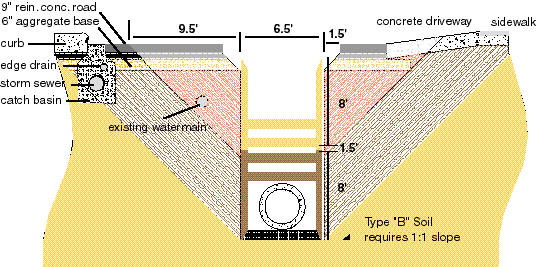
The James River Group of Companies
Home Specials Lasers Surveying Trench Shoring Construction Contact Service & Repair
How To . . .
The following information is useful for determining the proper trench shielding for your projects.
| How
to Size a Trench Shield Depth of cut* ____________ Soil conditions* Type A (25#) ____________ Type B (45#) ____________ Type C (60#) ____________ Hydrostatic ____________ * see depth certification chart Outside Pipe Diameter___________ (Shield must be a minimum of 12 wider than the pipe.) Pipe Length ___________ (Shield must be 2 to 4 longer than the pipe.) Bucket Width ___________ (Inside shield: 12 less than shield.) Machine Lift Capacity ___________ (1.5 times shield weight at 20 radius.) |
The following will explain how to determine
the specifications listed above.
How to determine the depth of cut:
g
Slope must start 18 or 1.5 feet
below the top of the Shield.
How to determine the width of a trench shield:
g
Trench Shield width determined by O.D. of
the pipe or the O.D. of the excavator bucket.
g
Allow 6 of clearance on each side of pipe
bell.
g
Shield should be a minimum of 12 wider than
the excavator bucket O.D.
How to Determine the
length of a trench shield:
g
Inside length clearance of pipe is
approximately 2 ft. less than the overall length of the shield.
g
Shield must be 2 to 4 longer than the
pipe.
How to Determine the machine lift capacity:
g
1.5 times the shield weight at 20
ft. radius at grade.
Calculating Depth
Ratings
g
PSF ratings and depths are based on
short term exposure with excavation open a period of time equal to 24 hours or
less.
Lateral pressure per foot of depth:
g
Type A Soil = 25 lbs.
g
Type B Soil = 45 lbs.
g
Type C Soil = 60 lbs.
Depth rating using shield capacity (lbs.):
g
1200 / 25 = 48 ft.
g
1200 / 45 = 27 ft.
g
1200 / 60 = 20 ft.
Soil Definitions
g
Apparent
cohesion
g
Cemented
soil
g
Layered
soil
g
Plastic
g
Saturated
soil
g
Submerged soil
No soil is Type A if:
g
it
is fissured.
g
it
is subject to vibration.
g
it
has been previously disturbed.
g
it
is part of a sloped, layered system which dips into the excavation on a slope of
4 horizontal to 1 vertical [4H:1V] or greater.
g
it
is subject to other factors requiring classification as less stable.
Type B Soil
g
Cohesive
soil with unconfined compressive strength greater than 0.5 tsf but less than 1.5
tsf.
g
Granular
cohesionless soils, e.g., gravel, silt, silt loam, sandy loam.
g
Type
A fissured or subject to vibration.
g
Unstable
dry rock.
g
It
is part of a sloped, layered system which dips into the excavation on a slope
less steep than [4H:1V], but only if the material would otherwise be classified
as type B.
Type C Soil
g
Cohesive
soils with unconfined compressive strength of 0.5 tsf or less.
g
Granular
soils including gravel, sand, and loamy sand.
g
Submerged
soil or soil from which water is freely seeping.
g
Submerged
rock that is not stable.
g
Sloped, layered system which slopes
into an excavation at an angle of 4H:1V or steeper.
Sloping vs. Trench Shields
Items having a high potential for cost over
runs are:
g
Excessive excavation due to trench
sloping.
g
Trucking excavated material from the
job site.
g
Importing specified trench backfill
material.
g
Excessive crew down time due to
waiting for bedding stone or repair of damaged existing utility.
g
Roadway and lawn restoration.
g
Pipe testing and leak repair.
g
Documenting sewer and lead locations.
Unnecessary excavation due to sloping results
in:
g
Higher trucking costs for removing
excavated material.
g
Higher cost of importing backfill.
g
Higher street and lawn restoration.
g
More excavator cycles per cut.
g
Higher crew costs due to increased
time of waiting for excavator to cut sloped trench.
g
Lower pipe production.
g
Possible liquidated damages due to
inefficiency.

The High Cost of
Restoration
Street and lawn restoration costs for projects in cities and subdivisions can be
higher than the cost of laying the pipe. This illustration shows how the proper
use of trench shields eliminates unnecessary excavation thus reducing the damage
to streets, lawns, sidewalks, and existing utilities.
